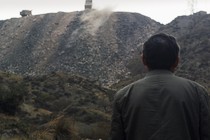Behemoth: The beast that is civilisation
by Sabine Kues
- VENICE 2015: Zhao Liang returns to Venice with a documentary Divine Comedy – a journey into the hell created by civilisation

Award-winning Chinese director, writer and cinematographer Zhao Liang is presenting another courageous documentary on social injustice at the Venice Film Festival: Behemoth [+see also:
trailer
film profile]. With his previous works, the director has travelled to such major festivals as Cannes in 2009 with the documentary Petition and the Berlinale 2011 with Crime and Punishment. His work also includes video installations that have been shown in museums and exhibitions worldwide. The five-hour long version of Petition was screened at MoMA in New York in 2013.
With Behemoth, the director embarks on a journey into hell, just like Dante before him in his Divine Comedy. The literary model provides the structure for the documentary's journey through the Inferno, Purgatorio and Paradiso (separated by red, grey and blue coloured screens). In a similar way to Dante's journey, the narrator is accompanied by a guide who, in Zhao's case, takes him to a coal mine on the prairies of Mongolia and, as they approach hell, inside an iron foundry. The Purgatorio shows the workers suffering from their illnesses caused by their work, awaiting either cure or death. Arriving at Paradiso, the documentary sarcastically shows what all this human suffering and exploitation of natural resources has been for: creating ghost cities full of desolate, modern high-rises, the outcome of a burst real-estate bubble.
The film impresses with extreme long shots depicting the landscape in all its breadth, highlighting the scope of destruction with the lush green grass of the Mongolian prairies contrasting with the huge grey mountains of debris from the mine. Behemoth, the mystical beast created by God, is found in several guises, as man-made machines at work. The images of the mine seem to be taken from another planet, with the machines performing their work as if guided by a magical hand. In the darkness, the air is full of clouds of dust that make the machines’ little red lights glow even brighter. The red colours naturally intensify as the film ventures further down the funnel of hell to the bright-orange flows of molten metal. The descent is felt all the more intensely thanks to the long sequence of an elevator taking men deeper and deeper down into the mine. The further down they get, the more deafening the sounds of the drilling machines and the louder the explosions from the mountain being blown into pieces. Every audio-visually intense scene is followed by a calm and quiet episode where we see the workers cleaning themselves in their homes, making them human again. The lingering close-ups on the workers’ dirty faces finally give them a satisfying onscreen presence. While the images of the workers are presented in a more observational style, the episodes guided by a narrative voice introduce more visual effects by working with the film's materiality and splitting the images up on screen, as if the viewer were looking through broken glass.
Zhao Liang chooses to let the images and the soundscape tell the story of his journey into the greediness of civilisation, as there is no further dialogue apart from the sparsely used narrator’s voice. And truly, nothing more can be said.
This Chinese-French co-production with Arte France will be broadcast on Arte on 19 November and is produced and sold internationally by INA.
Did you enjoy reading this article? Please subscribe to our newsletter to receive more stories like this directly in your inbox.
























